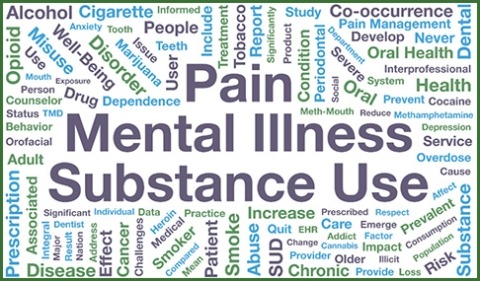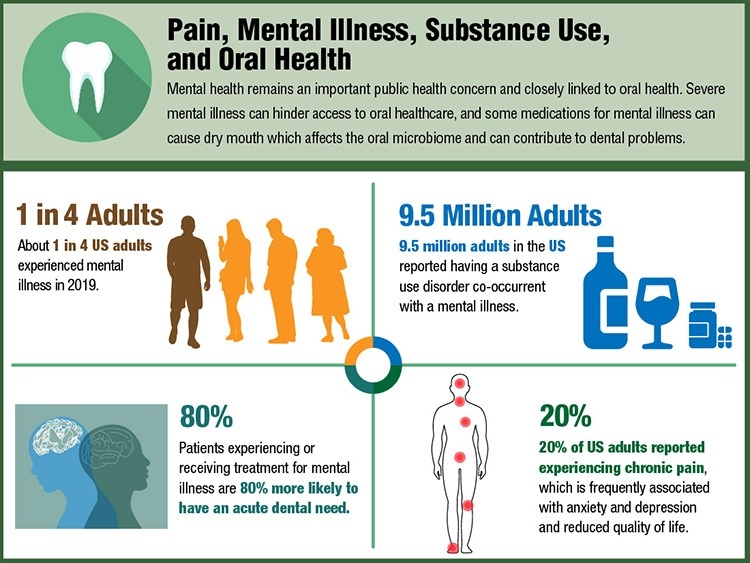Oral Health in America - November 2022 Bulletin
Section 5 Summary
Pain, Mental Health, Substance Use, and Oral Health
Section 5 of the oral health report reflects a growing understanding of the relationship between pain, mental health concerns, substance use, and oral health.
Pain can signal the presence of mental or physical (including dental) problems, or a combination of these, and may occur as a consequence of correcting or treating those problems. Managing orofacial pain is a common responsibility of oral healthcare providers, and understanding pain is essential for caring for patients with both mental illness and substance use disorders.
Substance use disorders that occur alongside mental illnesses are also much more common than previously assumed. Of the 19.3 million Americans with substance use disorders, nearly half also had a distinct mental illness. There is extensive evidence of a strong association between psychiatric disorders and poor oral health; people with severe mental illness have particularly high rates of periodontal disease and tooth decay, often as a consequence of their medications and potential challenges for self-care.
Status of Knowledge, Practice, and Perspectives
In 2016, an estimated 20% of U.S. adults experienced chronic pain, and about 8% had high-impact chronic pain. The prevalence of chronic orofacial pain is not as well documented, but a 2016 prospective study reported an annual incidence of nearly 4%. The high prevalence of pain in the population poses a major societal burden, indicating a need to better understand the impact of pain and its biological mechanisms.
Better understanding of the problem can also alter prescribing practices of dentists and other medical professionals. Eighty percent of the world’s prescription opioid analgesics are consumed in the United States. Since opioids suppress pain, people using these drugs can miss the warning signs of tooth decay and progression to abscess. In 2011-2016 opioid use was associated with a higher number of missing teeth, with 26.3% of long-term opioid users missing 20 or more teeth. Beyond their indirect effect on oral health, opioids also directly impact oral health by reducing salivary flow.
Advances and Challenges
Because so many addictions—especially opioid addictions—begin with the experience of pain, researchers have focused their efforts on elucidating the underpinnings of chronic pain and distress. Understanding the mechanisms involved in pain development has led to the creation of more effective modes of treatment. Additionally, more attention has been placed on dental prescribing practices, particularly after third molar (wisdom tooth) extraction, which is frequently a first-time exposure to opioids for younger patients. Major interventions to curtail opioid prescribing are ongoing, and recognition of the equivalent or superior performance of alternative pain medications is growing. People with mental or substance use disorders are often stigmatized or marginalized, and health care providers—including dentists—are not immune to social biases shared by the public at large. Patients are more likely to return if they feel their providers are kind, caring, patient, gentle, helpful, and fair. Stigma around a patient’s mental or substance use disorder can hinder the development of clinical relationships that are important to optimal care.
Promising New Directions
Recent research has increased our understanding of the neurobiological mechanisms that link mental illness and substance use. Substance use disorders are now understood as a form of mental illness, and three major hypotheses have been developed to explain the comorbidity of substance use and other mental illnesses. Researchers are working to determine whether substance use alleviates symptoms of mental illness or leads to changes in the brain that promote mental illness, or whether both mental illness and substance misuse share neurobiological mechanisms that increase vulnerability.
Scientists are also exploring the role of the oral microbiome in the interplay of substance use, mental health, and oral disease. The degree to which smoking and other substance use impacts the composition of microbial communities in the oral cavity is emerging as a particularly significant area of research. Microorganisms do not stay in the oral cavity but can translocate to other parts of the body, causing infection and inflammations at non-oral sites. Oral bacteria in non-oral sites have been linked to conditions like atherosclerosis, Alzheimer’s disease, and rheumatoid arthritis and more work is being done to determine what relationship the oral microbiome might have with these conditions.
Additional Takeaways
Taken together, substance use disorders and mental illness are common, recurrent, and treatable. However, these conditions can directly worsen oral health, alternatively, medications used to treat these conditions can have adverse side-effects on a patient’s oral health. Overcoming these challenges will require greater integration of mental, oral, and general healthcare. In particular, dental professionals must acquire new competencies related to the behavioral health aspects of substance use and mental illness to provide optimal care including disease prevention and appropriate referrals for patients with substance use disorders and mental health problems.
Q&A with Section Editor
Q&A with Christian S. Stohler, DMD, DrMedDent, senior editor Section 5: Pain, Mental Illness, Substance Use, and Oral Health.
What are some important takeaways about this section?
Complex clinical presentations call for collaborative practice of medical, behavioral, and dental health care providers.
Section V represents the first report issued by the U.S. oral health community and NIDCR about the comorbidity of oral health, pain, and behavioral health and substance use conditions. It zeroes in on a blind spot of the dental profession, focusing on a subject that intersects with the U.S. opioid crisis.
Without even considering their interrelationship, oral disease, pain, and behavioral and substance use conditions all remain undertreated in vulnerable populations. The healthcare environment within which these health conditions are addressed is highly fragmented. Given that oral disease, pain, and behavioral and substance use conditions feed on each other, novel programs are called for that offer an overarching perspective for the millions of impacted Americans to improve their physical and mental well-being and employability. The magnitude of the problem has reached a level of gravity that puts the effectiveness of current care practices into question.
Major investments in the workforce and technology are needed in support of interprofessional collaborative practice. Moving from a fragmented system of care to an environment that offers coordination between medical, mental, and dental care delivery necessitates a patient-centered and accountable patient management platform.
What was a surprising finding?
Oral health, pain, and behavioral health and substance use conditions represent a blind spot for the dental profession.
It is surprising how much is known about the prevalence of mental health and substance use among the U.S. population, including the special vulnerability of adolescents with respect to mental health and substance use. According to the Substance Abuse and Mental Health Services Administration (SAMHSA), 55.1 million U.S. adults were impacted by mental illness in 2019; 19.3 million U.S. adults had a substance use disorder (SUD). Of those with SUD, 9.5 million adults also had a mental health condition. These disease demographics emphasize the current environment within which oral health services are currently administered.
Another area of concern is opioid prescriptions for adolescents. Because alveolar and orthognathic surgeries are common among adolescents, dental professionals have an obligation to responsibly manage postoperative pain without inflicting harm. The assumption that opioids are the most effective postoperative pain medications is wrong; combinations of ibuprofen and acetaminophen should be considered as the first choice of treatment. Regarding risk, persons with depressive preoccupation are more likely to extend use of opioid prescriptions after wisdom tooth removal than those without depression. Given the vulnerability of the human brain between the ages of 18-25 years, published data make it difficult to justify the prescription of opioids to adolescent patients following dental and maxillofacial surgeries.
What should the American people know about this section of the report?
Mental health and substance use conditions as well as persistent pain are associated with above average levels of compromised oral health.
With multimorbidity on the rise in the U.S., the working interface between the oral health community and the healthcare community needs to be defined in operational terms.
Insufficient attention is given to the oral health of individuals with mental illness, substance use conditions and persistent pain. The fact that persons with these conditions are stigmatized, marginalized, and often poor make matters worse. Public opinion regarding persons with mental illness, substance use conditions, and persistent pain have not changed much in the past two decades.
Focusing on oral health, psychotropic medications as well as licit and illicit drugs contribute to oral health issues, including dental caries, periodontal disease, oral abscesses, mucosal dysplasia, xerostomia, and tooth wear. Eating disorders are associated with tooth erosions and decay. Compromised personal hygiene, notably inadequate oral hygiene, is common among persons with mental health and substance use disorders. Broad awareness of these relationships will accelerate the integration of the oral needs of those patients.
What is the main call to action?
Improving the lives of people with mental health, addictive disorders and persistent pain by addressing their oral health needs.
Integrating care for mental illness, addictive disorders, and conditions of persistent pain within the U.S. health system remains a challenge. For such integration to occur, oral healthcare professionals must acquire competencies in interprofessional practice. Recent additions to U.S. Dental Accreditation Standards, calling for dental students’ training in interprofessional practice are expected to develop a dental workforce capable of navigating across the “medical-mental-dental” divide. Dental practitioners’ attitudes toward people with persistent pain, mental illness and substance use disorders can be stigmatizing, necessitating changes in dental education and practice.
Christian S. Stohler, DMD, DrMedDent, is the Dean of the Columbia University College of Dental Medicine. He received his DMD and DrMedDent degrees from the University of Bern, Switzerland, where he also received certificates in oral surgery and prosthodontics. He is an expert on pain management and jaw disorders.
Did You Know?
Learn more about Oral Health in America: Advances and Challenges
Subscribe to receive monthly emails that highlight information in the NIH report Oral Health in America: Advances and Challenges.
June 2024




